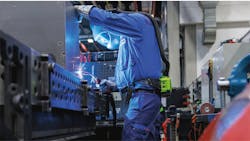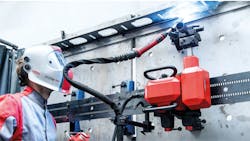The case for ergonomic welding
Whenever series production is not a consideration, welding is frequently carried out by hand. Welders often work in positions that strain the joints and muscles, for example, when welding while forced to adopt awkward postures, which results in complaints such as sprains of the lower back or arms.
This not only affects the health of welding professionals, but also comes at the expense of the company’s productivity. Companies are therefore increasingly focusing on ergonomics during welding.
What is meant by ergonomics?
Ergonomics has several meanings, one of which is quite literal: the term is derived from the Greek words “ergon” and “nomos.” “Ergon” means work and “nomos” translates as law. The word ergonomics can therefore be translated as “law of work.”
Another significant (and practical) definition of the term “ergonomics” is the mutual adaptation of people and their working conditions. Ergonomists try to design the workplace in such a way that it does not impair the physical or mental health of workers.
The same applies to welding workplaces.
“These should be designed to meet the physical requirements of welders and enable predominantly focused work that does not cause fatigue,” emphasizes Peter Fronius, head of strategic product management, professional welding tools, Fronius International. “For example, by taking the height or arm reach of the welders into account. If workplaces do not satisfy ergonomic standards, the likelihood of sickness, injury, and absence through illness increases.”
Of course, ergonomic risk factors cannot be eliminated every time and everywhere. This is the case for out-of-position welding, for example, where the aim must be to limit the time that the individual spends in the situation as much as possible.
See also: High- and low-tech ways to improve shop ergonomics
Risk factors when welding
Most causes of injury are not restricted to specific industries, but result from the movement and behavior patterns of welders. Typical here are repeatedly stretching the body, twisting the spine, being supported by or kneeling on hard surfaces, maintaining the same posture over a longer period of time, or a lack of rest.
If these risk factors occur repeatedly, they can lead to work-related musculoskeletal disorders (MSDs), in other words injuries and diseases that affect muscles, nerves, tendons, ligaments, joints, intervertebral discs, skin, subcutaneous tissue, blood vessels, or bones.
In addition to the causes previously mentioned, unfavorable environmental conditions such as extreme temperatures can also contribute to the development of MSDs, while personal risk factors such as physical condition, pre-existing illnesses, or age also come into play.
Work-related musculoskeletal disorders in welders
These disorders usually develop as a result of micro-traumas acting on the body over time and causing conditions such as lumbar slipped discs, the most common herniated discs due to the overall weight of the spine sitting most heavily on the two lower discs. These intervertebral discs consist of flexible, annular cartilage that contains semi-liquid gel. If a welder repeatedly lifts heavy components while adopting an unfavorable posture, this cartilage can degrade and tear over time. This results in the intervertebral disc bulging, pressing on a spinal nerve, and causing severe pain.
The most common musculoskeletal disorders include back injuries, bursitis, inflammation of the tendon and tendon sheath, carpal tunnel syndrome, and thoracic outlet syndrome. This disorder, which can occur due to compression of nerves, arteries, or large veins in the neck and chest area, is very painful and can be caused by frequent overhead welding.
Ergonomics and welding are not contradictory
Time and again, welders are forced to adopt unfavorable postures for a variety of tasks—frequently over long periods of time. It is often easier for the welder to move around large, heavy components themselves than to move the component into the optimum welding position.
Is it therefore paradoxical to talk about ergonomics and welding in the same sentence? Absolutely not.
Because despite all the hindrances, there are plenty of ways in which welding companies can design workplaces and work equipment ergonomically. Effort that is generally rewarded by a healthier workforce, better morale, higher productivity, and enhanced product quality. For example, height-adjustable welding tables and stools are tried and tested means of adapting the welding height to the physical requirements of welders.
See also: Three steps to improve vehicle maintenance technicians' health and wellness
Ideal for long seams: welding carriages
In industries where surface geometries vary, such as shipbuilding or container construction, the Fronius FlexTrack 45 Pro has three different rail types that can suit different requirements.
Welding 24/7 without physical effort
Nowadays, cobot welding cells mean that the automated welding even of small batch sizes is cost-effective.
“(Fronius' CWC-S from) is easy to use, even without programming knowledge, and there is no physical effort required,” Neuhofer said. “Your software remembers the welding sequences of the individual components, which are mounted either on a welding table or turn-tilt positioner. The components are welded fully autonomously in a protective cabin with an automatically closing and opening glare protection screen, which protects the welder from arc radiation—around the clock if necessary. If desired, the CWC-S can also be equipped with a fume extraction system.”
Heavy components should be lifted while fastened to lifting aids, such as indoor cranes, in order to protect the muscles and spine. This rule essentially applies to all lifting activities related to welding, because overloading the musculoskeletal system not only endangers health in the long term, but can also result in instant injuries such as lumbar syndrome, also commonly referred to as lumbago.
Orbital welding systems relieve the spine
Pipelines that are often used in the food industry or in power plant construction are produced using orbital welding, whereby the welding torch is guided around the pipe. They often have to be joined at unfavorable heights and positions, which can have an adverse effect on the welder’s back.
Orbital systems, such as the open and closed welding heads from Fronius, include a welding torch that automatically moves around the component and welds the seam.
See also: Tune up your fleet maintenance with ergonomic arms
Learning to weld without risking injury
Fronius provides a Welducation Simulator where trainees can familiarize themselves with welding, reducing the risk of injury. They create different welds without putting themselves at risk due to arc radiation and welding fume, using ergonomically shaped welding torches and while adopting different welding positions, including out-of-position welding postures.
The components used for the different simulations are made of lightweight plastic, which protects the muscles and spine of future welding experts.
In summing up, there are many ways in which to make the working environment of professional welders as safe and ergonomic as possible, and in doing so positively influence the working conditions and motivation of employees. This in turn enhances not only cost effectiveness for the company but also public perception.

